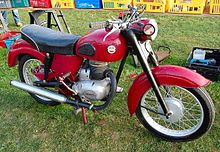James Cycle Company
| James Cycle Company Ltd | |
|---|---|
| legal form | Limited |
| founding | 1880 |
| resolution | 1966 |
| Reason for dissolution | insolvency |
| Seat | Greet ( Birmingham ), United Kingdom |
| management | Harry James, Charles Hyde |
| Branch | Bicycle manufacturer, motorcycle manufacturer |
The James Cycle Company Ltd was a British bicycle and motorcycle manufacturer that was based in Constitution Hill , Sparkbrook and Greet near Birmingham from 1880 to 1951 . The brand was then continued by AMC until 1966 .
history
From the foundation to the First World War
Harry James , a manager of a mechanical engineering company in Birmingham , decided in 1880 to start his own bicycle manufacturing company. In the same year he created the James Cycle Company in Constitution Hill near Birmingham. In 1890 the company, whose business was doing well, moved to larger premises in Sparkbrook . At the same time, James hired Charles Hyde as managing director. In 1897 he floated the James Cycle Company and withdrew from the company.
In 1902, Hyde decided to get into the motorcycle business. Initially, the bicycles received built-in motors from the Belgian manufacturer Minerva . In 1904 the frames were adapted to the engine to be installed at the lower end of the frame triangle and the engines came from the Belgian FN. In 1908 James manufactured his own 500 cm³ single-cylinder engine with concentric inlet and outlet valves. The motorcycle had the petrol and oil tank over the front wheel and a saddle built on leaf springs. The rear wheel was driven with a leather belt. The belt drive also served as a clutch. The wheels were mounted on one side on quick-release axles. The James was the first motorcycle to have internal shoe brakes. The model was built in this form until 1911.
From 1911 onwards, James built more conventional motorcycles with symmetrical parallelogram forks, plug-in tanks, multi-disc oil bath clutches and two-speed transmissions. In the same year the company bought Osmonds Ltd in Greet . Fred J. Osborn had built one of the first two-stroke motorcycles in the UK there. James adopted the design principle from 1913 for the smaller motorcycle models, which were built parallel to the large four-stroke models with single and two-cylinder engines up to 600 cc. During the First World War , the company had to stop building large machines in order to create ammunition production capacity.
From the First World War to the takeover
With the peace treaty of 1918, James resumed its full range, but a fire damaged production so that it took until 1922 before the company was able to build motorcycles again to the desired extent - now exclusively in Greet. In the 1920s, the company offered - partly under its own name, partly under the name Osmonds - all common sizes and types of motorcycles, from small two-stroke models to four-stroke models with side-controlled engines to those with OHV valve control . Among them was a 500 cc ohv V2 model from 1928, with which the company took part in speedway races.
From the end of the 1920s, James stopped building his own two-stroke engines and instead installed those from Villiers . In 1932, however, they again launched their own 150 cc two-stroke engine. James bought Baker Motor Cycles , which specialized in bolted (rather than brazed) frames. In the 1930s, the production of engines was gradually stopped completely and the company concentrated on smaller motorcycles with displacements from 98 to 250 cm³. Most recently, in the mid-1930s, a huge V2 SV engine with 750 cm³ displacement and sack cylinders was built, which James installed in a three-wheel delivery van called the Samson Handyvan . The engines for the motorcycles came again exclusively from Villiers.
During World War II, James supplied the British military with the 125 ML (Military Lightweight) and the 98 Junior , small, light motorcycles that were also used on the Normandy landings . With these two models James started the peace production again in 1946. Until 1951 a 200 cc model could be offered again.
Under AMC direction
In 1951, the James Cycle Company Ltd was taken over by AMC . As a result, there were the models Cadet , Cavalier and Commodore with Villiers two-stroke engines of 150, 175, 200 and 250 cm³. A 150 cm³ motor scooter , popular at the time , was also added, but it came too late for the British market. Vespa and Lambretta had already divided this market between themselves.
In 1957, James was merged with Francis-Barnett . In order to face the growing Japanese competition, AMC even briefly formed a joint venture with Suzuki , Suzuki (GB) Ltd , which resided in the buildings of the former James Cycle Company Ltd. In the mid-1960s, a new Cadet with an open tubular frame appeared again . It was the last model to be named James , as AMC went bankrupt in 1966 .
Post war models
James manufactured the Autocycle with 98 cm³ displacement, the Comet with 125 cm³ displacement, the Commodore , 1954–1955 the Colonel with 225 cm³ Villiers single-cylinder engine , various Captain and Trial motorcycles and scramblers. In 1956 they built the Captain 200 K7C and the Commando 200 K7T , both with 197 cc engines. The most important model was the Cadet with a 150 cc engine, the syringe model, the Superswift, with a 250 cc two-cylinder four-stroke engine , which also came from Villiers.
source
- Ian Ward, Laurie Caddell (Editor): Great British Bikes . Orbis Publishing, London 1984. ISBN 0-85613-605-0 . James . Pp. 77-81. (English)

